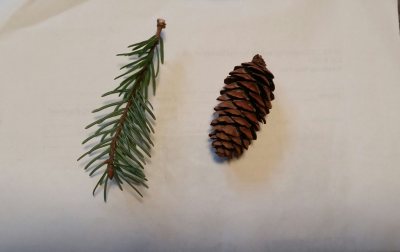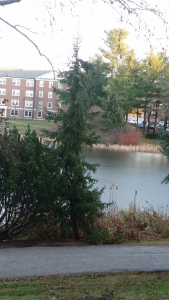Serbian Spruce
Picea omorika | Family: Pinaceae
Submission: Ben Schmandt ’22 and Alex Bickart ’21
Leaves – Evergreen needles; ½ -1” in length, flat, and attached directly to the twig via a small peg. Needles are dark green above, with prominent glaucous white stomatal bands beneath.
Twigs and Buds – Narrow, pendant branches, upcurved branch tips. Pubescent new growth twigs. Lateral and terminal buds are ovoid, imbricate and often reflexed. Buds are occasionally resinous.
Cone – 1.25”-1.75” long, pendulous and oblong, ranging from violet to blue/black when immature, and progressing to a nutmeg brown at maturity. Persistent for up to five years, and cycle between strong and weak coning years.
Bark – Dark brown, separating into thin, scaly plates on older trees.
Natural History:
The point of origination of Serbian spruce (Picea omorika) has been heavily contested. Competing studies have claimed that the species originated in either Asia approximately 16 million years ago, or North America, just 2-3 million years ago. In modern day, the species hails from a limited area within western Serbia and eastern Bosnia and Herzegovina, and occupies a range of just 4,076 km². Due to its highly fragmented population, it has been labeled as an endangered species. The natural habitat of the Serbian spruce is limited to north-facing limestone slopes between a half and one mile above sea level. The tree is currently under increasing threat due to habitat loss from climate change, as well as low genetic diversity within the population. Prior to the large-scale industrial revolution of eastern Europe, the range of the Serbian spruce was largely continuous, stretching across much of Bosnia and Herzegovina, and the entirety of Serbia. Illegal logging had a severe impact on the tree’s population through the 19th and 20th centuries, as the trees’ remote habitat made them a prime target for lumber poaching. Fire has also served as a major inhibitor to the growth of the population, as wildfires and deliberate burns have cut large swaths in the species’ natural habitat.
 Despite its sparse distribution and threatened natural habitat, the Serbian spruce is growing in popularity as an ornamental species; it is classically considered one of the most attractive of the spruces due to its graceful trunk and sweeping, silvery branches, which form a narrow spire. As an ornamental, the Serbian spruce is classified as a hardy species. It grows best in full to partial sun, with rich, well drained, and slightly basic soil, but is known to tolerate wide variation in soil pH and type, as well as water level. This makes the tree particularly well suited as an urban ornamental, or for use in other areas with similarly sparse resources and variable soil quality. Of particular threat to ornamental populations in the United States is the presence of Armillaria solidipes. This aggressive pathogenic fungus invades the sapwood of coniferous trees like spruces, pines, and hemlocks, spreading rhizomorphs beneath the bark. These hair-like structures can travel great distances within the trees bark, and even between trees, and serve to collect nutrients for the fungus. This is heavily damaging, and will cause root rot and the drying and desiccation of the crown of the tree. Despite this threat, the species thrives as an introduced ornamental. Beyond its function as a decorative species, the Serbian Spruce serves relatively little commercial value, as its low population size and slender trunk growth provide little substantive material for commercial use.
Despite its sparse distribution and threatened natural habitat, the Serbian spruce is growing in popularity as an ornamental species; it is classically considered one of the most attractive of the spruces due to its graceful trunk and sweeping, silvery branches, which form a narrow spire. As an ornamental, the Serbian spruce is classified as a hardy species. It grows best in full to partial sun, with rich, well drained, and slightly basic soil, but is known to tolerate wide variation in soil pH and type, as well as water level. This makes the tree particularly well suited as an urban ornamental, or for use in other areas with similarly sparse resources and variable soil quality. Of particular threat to ornamental populations in the United States is the presence of Armillaria solidipes. This aggressive pathogenic fungus invades the sapwood of coniferous trees like spruces, pines, and hemlocks, spreading rhizomorphs beneath the bark. These hair-like structures can travel great distances within the trees bark, and even between trees, and serve to collect nutrients for the fungus. This is heavily damaging, and will cause root rot and the drying and desiccation of the crown of the tree. Despite this threat, the species thrives as an introduced ornamental. Beyond its function as a decorative species, the Serbian Spruce serves relatively little commercial value, as its low population size and slender trunk growth provide little substantive material for commercial use.
References:
Aleksić, J.M., Ballian, D., Isajev, D., Mataruga, M., Christian, T. & Gardner, M. 2017. Picea omorika. The IUCN Red List of Threatened Species 2017: e.T30313A84039544. http://dx.doi.org/10.2305/IUCN.UK.2017-2.RLTS.T30313A84039544.en. Downloaded on 10 November 2019.
Bates R. Species: Serbian Spruce – Picea omorika. 2019 [accessed 2019 Nov 21]. https://ento.psu.edu/extension/christmas-trees/cultural-information/species-serbian-spruce-picea-omorika
Fitzpatrick-Cooper J. Plant Profiles: HORT 2242 Landscape Plants II. 2014 [accessed 2019 Nov 21]. https://dc.cod.edu/horticulture-2242-picea-omorika/picea-omorika.pdf
Kuo M. Armillaria solidipes. Mushroom Expert. 1016 Dec [accessed 2019 Nov 21]. https://www.mushroomexpert.com/armillaria_solidipes.html
Picea omorika. Gardening Help. 2019 [accessed 2019 Nov 21]. http://www.missouribotanicalgarden.org/PlantFinder/PlantFinderDetails.aspx?kempercode=h220
